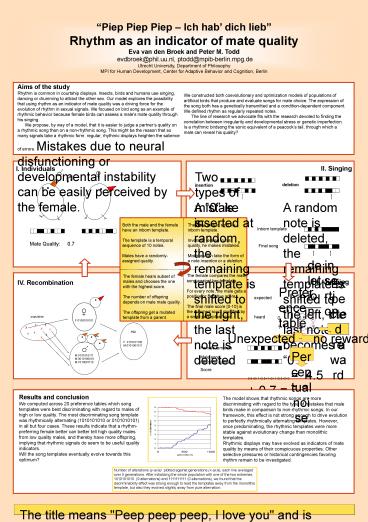PowerPoint PPT Presentation
1 / 1
Title:
1
Piep Piep Piep Ich hab dich liebRhythm as
an indicator of mate qualityEva van den Broek
and Peter M. Todd evdbroek_at_phil.uu.nl,
ptodd_at_mpib-berlin.mpg.de Utrecht University,
Department of PhilosophyMPI for Human
Development, Center for Adaptive Behavior and
Cognition, Berlin
Aims of the study Rhythm is common in courtship
displays. Insects, birds and humans use singing,
dancing or drumming to attract the other sex. Our
model explores the possibility that using rhythm
as an indicator of mate quality was a driving
force for the evolution of rhythm in sexual
signals. We focused on bird song as an example of
rhythmic behavior because female birds can assess
a male's mate quality through his singing.
We propose, by way of a model, that it is easier
to judge a partners quality on a rhythmic song
than on a non-rhythmic song. This might be the
reason that so many signals take a rhythmic form
regular, rhythmic displays heighten the salience
of errors. Mistakes due to neural disfunctioning
or developmental instability can be easily
perceived by the female.
We constructed both coevolutionary and
optimization models of populations of artificial
birds that produce and evaluate songs for mate
choice. The expression of the song both has a
genetically transmitted and a condition-dependent
component. We defined rhythm as regularly
repeated notes. The line of research we
advocate fits with the research devoted to
finding the correlation between irregularity and
developmental stress or genetic imperfection. Is
a rhythmic birdsong the sonic equivalent of a
peacocks tail, through which a male can reveal
his quality?
II. Singing
I. Individuals
Two types of mistakes
deletion
insertion
A 0 is inserted at random, the remaining
template is shifted to the right, the last note
is deleted
A random note is deleted, the remaining template
is shifted to the left, the last note becomes a
0
The male tries to sing his inborn template.
Inversely related to his quality, he makes
mistakes. Mistakes can take the form of a
note insertion or a deletion.
Both the male and the female have an inborn
template. The template is a temporal sequence of
10 notes. Males have a randomly-assigned
quality.
Inborn template
Mate Quality 0.7
Final song
deletion
insertion
The female compares the male song against her
template. For every note, the male gets a
positive or negative score. The final male
score 0-10 is the summed score modified by a
small perceptual error.
The female hears subset of males and chooses the
one with the highest score. The number of
offspring depends on male mate quality. The
offspring get a mutated template from a parent.
III. Judging
I. Individuals
IV. Recombination
Preference table
population
F 0100100101
x
x
Expected reward
x
x
x
egg
x
x
x
Unexpected no reward
x
F 0110101100 M 0101001011
Female template
M 0101010111 M 0010100010 M 1010001110
Male song, heard by female
Score
0.5010.51010.500 4.5 0.7 5.2
Results and conclusion We computed across 20
preference tables which song templates were best
discriminating with regard to males of high or
low quality. The most discriminating song
template was rhythmically alternating (1010101010
or 0101010101) in all but four cases. These
results indicate that a rhythm-preferring female
better can better tell high quality males from
low quality males, and thereby have more
offspring, implying that rhythmic signals do seem
to be useful quality indicators. Will the song
templates eventually evolve towards this optimum?
The model shows that rhythmic songs are more
discriminating with regard to the type of
mistakes that male birds make in comparison to
non-rhythmic songs. In our framework, this effect
is not strong enough to drive evolution to
perfectly rhythmically alternating templates.
However, once predominating, the rhythmic
templates were more stable against evolutionary
change than monolithic templates. Rhythmic
displays may have evolved as indicators of mate
quality by means of their conspicuous properties.
Other selective pressures or historical
contingencies favoring rhythm remain to be
investigated.
Number of alterations (y-axis) plotted against
generations (x-axis), each line averaged over 5
generations. After initializing the whole
population with one of the two extremes,
1010101010 (9 alternations) and 1111111111 (0
alternations), we found that the discriminability
effect was strong enough to lead the templates
away from the monolithic template, but also they
evolved slightly away from pure alternation.
The title means "Peep peep peep, I love you" and
is derived from the song "Guildo hat euch lieb",
by Guildo Horn And The Orthopaedic Stockings,
Eurovision Song Contest 1998

